Attachments
Note: Not all attachments are visible to the general public. Research URLs will go live after the embargo ends.

Journal/
conference: JAMA Network Open
conference: JAMA Network Open
Research:Paper
Organisation/s:
University of Minnesota, USA
Funder:
Thisworkwas supported by the grants K23 HD112507 (principal investigator [PI], Dr Burrows),
K99 MH131841 (PI, Dr Zheng), R01 MH068398 and R01MH099046 (PI, Dr Ozonoff), P50 HD103526 (PI, Leonard
J. Abbeduto, PhD), P50 MH100029 and R01MH083727 (PI, Dr Klin), R01 MH059630 and 5U54MH066417U54
MH066417 (PI, Dr Landa), R01MH059630, R01 MH059630, RO1 NS12098, and R01 DC10290 (PI, Dr
Tager-Flusberg), R01 MH090194 and R01 MH107573 (PI, Dr Roberts), P50 HD055784 (PIs, Dr Jeste and Susan
Bookheimer, PhD), R01 HD054979 and R01 HD073255 (PI, Dr Iverson), P50 HD055782 (PI, DrWebb),
R01HD043292 (PI, Dr Stone), P50 MH115716, R01 MH087554, R01 MH100182, and R01 MH124892 (PI, Dr
Chawarska), U24 ES028533 (PI, Dr Schmidt), R01ES028089 and R01HD057284 (PIs, Drs Stone and Messinger),
R01 HD047417 (PI, Dr Messinger), R01 HD055741 (PI, Dr Piven), R01 HD052804 (PI, Dr Carver), R01 HD064820
(PI, DrWebb), R00MH092431 (PI, Dr Schwichtenberg), R01HD072018 (PIs, Athena Vouloumanons, PhD, and Dr
Curtin), and R01MH121416 (PI, Dr Miller) from the National Institutes of Health. Additional supportwas provided by
grants BSRC 17-001, BSRC 21-001, and BSRC 23-001 (PI, Dr Young) and BSRC 22-001 (PI, Lasso Informatics) from
the Autism Science Foundation; grants AS8370 (PI, Dr Ozonoff), AS6020 (PI, Dr Piven), and AS8431, AS7470, and
AS9494 (PI, Dr Young) from Autism Speaks; grants SFARI 386098 (PI, Dr Schmidt) and SFARI 140209 (PI, Dr
Piven) from the Simons Foundation for Autism Research; grants 62924 and 102665 (PIs, Jessica Brian, PhD,
CPsych, and Dr Zwaigenbaum) from the Canadian Institutes of Health Research; grants MR/R011427/1, G0701484,
MR/K021389/1, and MR/T003057/1 (PIs, Dr Charman, Mark Johnson, PhD, and Emily Jones, PhD) from the UK Medical Research Council; the Marcus Foundation and the Joseph B. Whitehead Foundation (PI, Dr Klin); and the
Georgia Research Alliance (PI, Dr Klin).



 International
International


